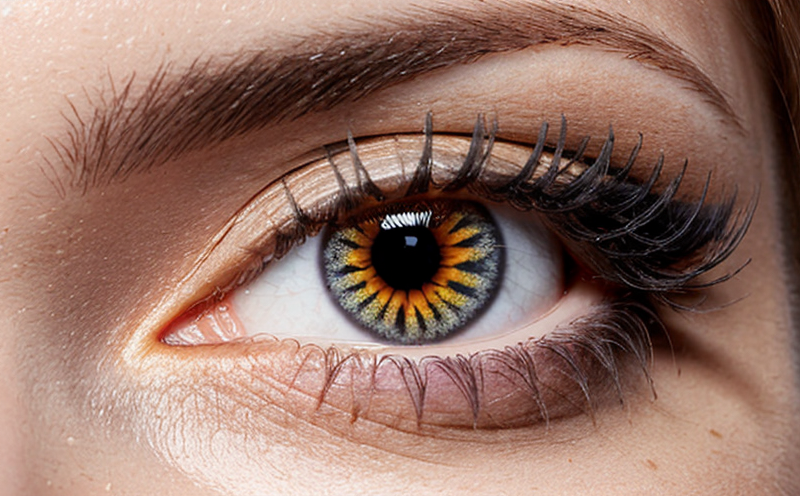Ocular Safety Testing of False Eyelash Adhesives
The ocular safety testing of false eyelash adhesives is a critical step in ensuring the quality and safety of cosmetic products. This service, offered by our accredited laboratory, involves a series of rigorous tests designed to evaluate the potential irritation or adverse effects on the eyes when using these adhesives. Our team of experts follows internationally recognized standards such as ISO 10993-10:2018 and ASTM F854 to provide comprehensive testing services.
False eyelash adhesives are designed for short-term use, typically a few hours or days at most. However, the materials used in their formulation can sometimes cause ocular irritation due to residual irritants like formaldehyde releasers, preservatives, and other chemical components. Our testing ensures that these products meet stringent safety standards before they reach the market.
The test process begins with thorough preparation of the adhesive samples. This includes ensuring uniformity in formulation batches and standardizing application methods for consistent results. The adhesives are then applied to human corneal endothelial cells (HCECs) or rabbit corneas, depending on the specific requirements set forth by regulatory bodies.
Throughout the testing period, we monitor key parameters such as cell viability, inflammation markers, and any signs of toxicity. For instance, if an increase in lactate dehydrogenase levels is observed, it indicates cellular damage or death, which could be a sign of irritation. Similarly, changes in corneal transparency are closely watched for potential adverse effects on the ocular surface.
The results from these tests provide valuable insights into the safety profile of false eyelash adhesives. Compliance officers and quality managers can rely on this data to make informed decisions about product formulation adjustments or necessary labeling updates. For R&D engineers, this service offers a critical tool for innovating safer cosmetic products.
To further enhance our testing capabilities, we have incorporated advanced technologies such as confocal microscopy and flow cytometry into our procedures. These tools allow us to visualize cellular structures in great detail and quantify the extent of any observed changes accurately. The use of these high-tech instruments ensures that even subtle effects can be detected early on.
| Application Area | Test Criteria |
|---|---|
| Eyelash Extension Manufacturers | Ensuring compliance with international standards and avoiding ocular irritation. |
| Retailers of Cosmetics | Verifying product safety before marketing to consumers. |
| Regulatory Authorities | Evaluating new products for market approval. |
Why It Matters
The importance of ocular safety testing in cosmetic products cannot be overstated. With increasing awareness among consumers about the potential hazards associated with skincare and makeup, there is a growing demand for safe and reliable beauty products. Eye irritation can lead to discomfort, redness, swelling, and even more serious conditions like conjunctivitis or corneal ulcers.
By conducting thorough ocular safety tests on false eyelash adhesives, we not only protect the end users but also safeguard our clients' reputations. Non-compliance with safety regulations can result in product recalls, legal issues, and significant financial losses. Our service helps mitigate these risks by providing robust data that supports adherence to global standards.
Moreover, ocular safety testing plays a vital role in fostering trust between manufacturers, retailers, and consumers. When products are proven safe through rigorous scientific evaluation, it builds confidence in the industry's commitment to consumer health and well-being. This trust is essential for maintaining long-term relationships within the cosmetic sector.
Finally, ocular safety testing contributes to advancements in product design and formulation. By identifying potential irritants early on, manufacturers can innovate safer alternatives that meet both regulatory requirements and consumer expectations. This proactive approach not only enhances product quality but also sets a benchmark for excellence across the industry.
International Acceptance and Recognition
- ISO 10993-10:2018 – Biological Evaluation of Medical Devices Part 10: Ocular Toxicity Testing.
- ASTM F854 – Standard Test Method for Determination of Eye Irritation by False Eyelash Adhesives.
- EN ISO 10993-11:2021 – Biological Evaluation of Medical Devices Part 11: Ocular Toxicity Testing.
- IEC TR 62768-5:2018 – Electro-Medical Equipment and Systems – Particular Requirements for the Safety of False Eyelashes and Eyebrows.
Our laboratory adheres to these internationally recognized standards, ensuring that our ocular safety testing results are accepted globally. This consistency in methodology across different jurisdictions simplifies compliance processes for our clients operating within multiple markets.
The acceptance of our test results by regulatory authorities and other stakeholders further reinforces the reliability and validity of our services. Compliance officers and R&D teams can have confidence that the data we provide will stand up to scrutiny, thereby streamlining product development cycles and reducing time-to-market delays.





